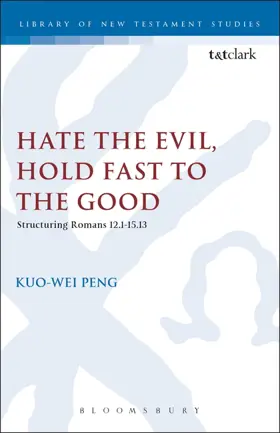

Hate the Evil, Hold Fast to the Good: Structuring Romans 12.1-15.13
in Library of New Testament Studies
Pages
244
Publisher
T&T Clark
Published
3/15/2006
ISBN-13
9780567030450
Peng outlines a plausible structure for Romans 12.1-15.13. After a brief survey of scholars' opinions about the structure of this passage, three methodologies (structural exegesis, discourse analysis, and rhetorical criticism) are analysed. Having acknowledged that each of these methodologies has its own limitations, an eclectic approach, which is analogous with 'putting together a jigsaw puzzle without the final picture', is suggested.
According to this 'jigsaw puzzle' analogy, the first portion of the 'puzzle' to be put together is Romans 12.9-21, followed by an analysis of chapter 13.1-7. Based upon the conclusions of these two chapters, a larger picture of chapter 12.9-13.10 is put together. After expanding the picture by including chapter 12.1-8 as well as chapter 13.11-14, an analysis of chapters 14.1-15.13 is carried out. The last step is to put together chapters 12.1-13.14 and chapters 14.1-15.13 to develop the final picture.
Peng also includes two appendices: the first is an assessment of the historical background of chapter 13.1-7 in light of the analysis presented; and the second is a short assessment of interpretations of the word 'pistis' in chapter 12.3 and 12.6, in which the rationale behind the interpretation of this term is discussed.
According to this 'jigsaw puzzle' analogy, the first portion of the 'puzzle' to be put together is Romans 12.9-21, followed by an analysis of chapter 13.1-7. Based upon the conclusions of these two chapters, a larger picture of chapter 12.9-13.10 is put together. After expanding the picture by including chapter 12.1-8 as well as chapter 13.11-14, an analysis of chapters 14.1-15.13 is carried out. The last step is to put together chapters 12.1-13.14 and chapters 14.1-15.13 to develop the final picture.
Peng also includes two appendices: the first is an assessment of the historical background of chapter 13.1-7 in light of the analysis presented; and the second is a short assessment of interpretations of the word 'pistis' in chapter 12.3 and 12.6, in which the rationale behind the interpretation of this term is discussed.
- Table of contents
- Introduction
- Chapter 1 Methodological Considerations
- Chapter 2 Analysis of 12.9-21
- Chapter 3 Analysis of 13.1-7
- Chapter 4 Analysis of 12.9-13.10
- Chapter 5 Analysis of 12.1-13.14
- Chapter 6 Analysis of 14.1-15.13
- Chapter 7 Synthetic Discussion of 12.1-15.13
- Conclusion: Structure and Method-A Meta-comment
- Appendix AAssessment of the Proposals for the Historical Background of 13.1-7
- Appendix BAssessment of Interpretations of 'pistis' in 12.3 and 12.6